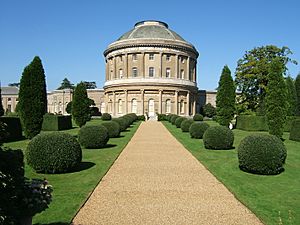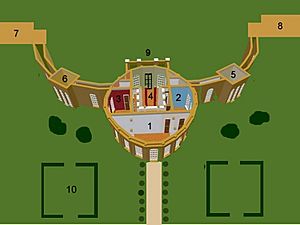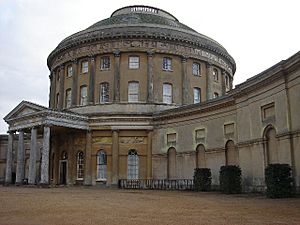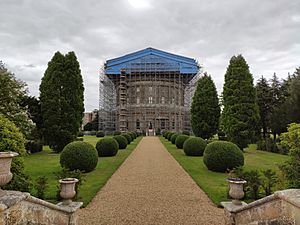Ickworth House facts for kids
Ickworth House is a beautiful country house located in Ickworth, near Bury St Edmunds in Suffolk, England. It's a neoclassical building, which means it was designed in a style inspired by ancient Greek and Roman buildings. The house is surrounded by a large park. For many years, it was the home of the Marquesses of Bristol. In 1956, the house was given to the National Trust, a charity that protects historic places.
Contents
History of Ickworth House
Ickworth House was built between 1795 and 1829. It was the main home for the Hervey family, who later became the Marquesses of Bristol. This family had owned the land since 1467.
Who Started the House?
The idea for the house came from Frederick Hervey, 4th Earl of Bristol, who was also a Bishop of Derry. He was known as the Earl-Bishop. He asked an Italian architect named Antonio Asprucci to design a classical-style villa for him in the English countryside. The Earl-Bishop originally planned for the house to be an art gallery. However, his art collection was taken by Napoleon. The Earl-Bishop died in 1803, so his family had to finish building the house.
Ickworth and the National Trust
In 1956, Ickworth House, its park, and money to help look after it were given to the National Trust. This happened instead of paying death duties (a type of tax). As part of this agreement, the Marquesses of Bristol were allowed to live in the 60-room East Wing for 99 years.
However, in 1998, the 7th Marquess of Bristol sold the rest of the lease on the East Wing back to the National Trust. Today, the family's former private East Wing is run as The Ickworth Hotel. There are also apartments in the Dower House on the grounds, which are also leased from the National Trust.
Finishing the West Wing
The West Wing of Ickworth House was not finished for a long time. It was finally completed in 2006. This was thanks to a partnership between the National Trust and Sodexo Prestige. The West Wing is now used for conferences and events. The first wedding ever held at Ickworth House took place there in 2006.
Architecture of Ickworth House
Ickworth House is one of England's most unusual houses. Some people have described it as looking like "a huge bulk, newly arrived from another planet." However, architects now see it as a very important building. It is compared to the grand works of architects like Boullée and Ledoux.
Design and Materials
The main idea for the design came from the Italian architect Antonio Asprucci. He was famous for his work at the Villa Borghese, which the Earl-Bishop had seen. Asprucci's plans were changed a bit, and the building work was managed by Irish architects Francis Sandys and his brother Joseph Sandys.
The outside walls of the house are made of brick covered in stucco. The roof is made of slate and lead. The central part of the house is a large round building called a rotunda. It is about 105 feet (32 meters) high and has a domed roof. You enter the building through a main entrance with an Ionic portico.
The rotunda is decorated with columns that stick out from the wall, called pilasters. On the lower floor, these are Ionic style, and on the upper floor, they are Corinthian style. The different levels of the building are separated by decorative bands called friezes.
Wings of the House
On either side of the rotunda are long, curved, single-story wings. These wings connect to two larger buildings at each end, called pavilions. This style is similar to palladian architecture.
The East Wing is like a small mansion itself. It was designed to be where the family lived every day. This meant the grander rooms in the rotunda could be saved for parties and showing off art. The West Wing was meant to be an orangery (a greenhouse for orange trees), a sculpture gallery, and service rooms. However, it remained an unfinished shell until the early 2000s. For a long time, it was used for storing farm equipment. The 4th Marquess even put a squash court in it!
Contents of Ickworth House
Ickworth House is filled with amazing art and treasures. It has paintings by famous artists like Velázquez and Titian. There are also many family portraits from the 18th century by artists such as Gainsborough, Reynolds, Vigee-Lebrun, Batoni, Angelica Kauffman, Ramsay, van Loo, and Hogarth.
The house also has a wonderful collection of Georgian silver. You can see beautiful examples of Regency furniture, porcelain, and 16th-century maiolica (a type of pottery). Geraldine Hervey, Marchioness of Bristol used to collect fancy decorated fans and silver fish.
Ickworth Church
Most members of the Hervey family, from Thomas Hervey (who died in 1467) to the 7th Marquess of Bristol (who died in 1999), are buried at Ickworth Church. This church is located in the park, just a short walk from the house.
The church is Norman in style, with some parts added later. It has a 15th-century wall painting of the Angel of the Annunciation. There's also a 15th-century font and round pieces of Flemish glass from as early as the 14th century. Inside, you can see many marble memorials to different members of the Hervey family over the centuries. The church is still owned by the Hervey family and has recently been repaired with help from English Heritage.
The Park at Ickworth
Ickworth Park is huge, covering more than 1,800 acres (about 7.3 square kilometers). The park is home to some of the oldest and most beautiful trees in the area.
One special tree is the Tea Party Oak. It is at least 800 years old and has a trunk that is over 9 meters (about 30 feet) wide! It is one of the oldest surviving oak trees in the county. Another very old tree, in Albana Wood, is about 600 years old.






